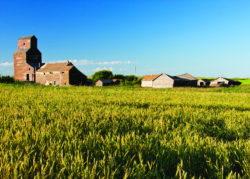 Menu
Menu
 Menu
Menu

Bents, in the RM of Marriott, was incorporated in 1930. Its last business, the Pool elevator, closed in 1977.
Though some municipalities in Saskatchewan date back to the late 1800s, most settlements sprung up in the early twentieth century when rail lines were built. So quick was the flood of settlers that Saskatchewan became the third-biggest province in Canada by 1911.
When Saskatchewan’s population shifted from rural to urban, many of these small communities fell into decline. Population loss—often combined with unfortunate circumstances—left places like Girvan, Robsart, and Lemsford as mere shadows of their former selves. Other communities like Estuary, Govenlock, and Expanse became true ghost towns, with mere skeletal remains left.
When a town or village is shrinking out of existence, it is often no longer practical and sometimes impossible to have a local municipal government. When this is the case, the municipality’s council can apply to be dissolved into the Rural Municipality in which it exists or the Minister of Municipal Affairs can order the dissolution. For example, in the RM of Usborne there are two former villages, Lockwood and Guernsey. Lockwood was dissolved in 2002 and Guernsey was dissolved in 2005. Both are now hamlets administered by the RM.
Sometimes when a municipality is entirely abandoned the town site may revert to privately-held property. For example, the ghost town of Bents—complete with an abandoned grain elevator, houses, and stores—exists entirely on privately-owned land. Formerly public spaces, like the town’s streets, are no longer public. This means you need permission from the land owner to explore these towns.
There is no standard world-wide definition of “city.” In Saskatchewan, a city requires a minimum population of 5000. In Alberta, 10,000 people are required. New Zealand requires at least 50,000.
Other places do not rely on population for a city designation. For example, the United Kingdom defines cities by using such factors as the community’s historical status and the presence of an Anglican cathedral.
Meanwhile, some jurisdictions have abolished “city” designations entirely. Quebec has no legal distinction between town and city, and Sweden calls all settlements kommun (Swedish for municipality).
With the population of several Saskatchewan towns recently moving past 5000, a debate has been ignited about what constitutes a “city.” Is 5000 residents enough to constitute a city? Or are other characteristics required?
Consider what makes a “city”:
Using your answers above, create your own definition of “city.” How would your definition apply to communities in Saskatchewan?